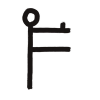Thoughtographs
Rose Choreographic School
An interview series that captures moments and movements within choreographic research practices. The dialogues aim at making visible the thought processes of artists, through language and other phenomenena, which might otherwise not be evident in presented work. Each discussion develops out of current concerns and speculates on potential manifestations, moving between past archives and future fabulations.

Thoughtographs is a series of interviews with artists where the conversation is an attempt to develop an image of practice, aware that any articulation is a projection, a condensation onto a page with some mediation and possible embellishment. The resultant portraits of choreographic research  hover between truth and artifice, documentation and magical elaboration. They are both captured moments within the development of a process, and evidence that phenomena
hover between truth and artifice, documentation and magical elaboration. They are both captured moments within the development of a process, and evidence that phenomena  we can’t see, or even name, accompany any artistic research.
we can’t see, or even name, accompany any artistic research.
The term thoughtography  was originally coined in the late 19th century as an English translation for the Japanese concept of nensha, which described an ability to project psychic images onto photographic paper. A thoughtograph was a developed picture of the mind, capturing thought and condensing it into a single image, and the technique emerged alongside spiritualist photography which captured ectoplasm, auras and other psychic phenomena undetectable to the naked human eye. The resultant images were seductive in their promise of evidence of psychic processes, but also vulnerable from the beginning to charges of trickery and falsification. In appropriating this word for this interview series we enjoy these traces of paranormal activity, belief in the more-than-visible, feigned documentation, imaginary capture and captured imagination; tendencies which haunt all artistic research.
was originally coined in the late 19th century as an English translation for the Japanese concept of nensha, which described an ability to project psychic images onto photographic paper. A thoughtograph was a developed picture of the mind, capturing thought and condensing it into a single image, and the technique emerged alongside spiritualist photography which captured ectoplasm, auras and other psychic phenomena undetectable to the naked human eye. The resultant images were seductive in their promise of evidence of psychic processes, but also vulnerable from the beginning to charges of trickery and falsification. In appropriating this word for this interview series we enjoy these traces of paranormal activity, belief in the more-than-visible, feigned documentation, imaginary capture and captured imagination; tendencies which haunt all artistic research.
Read more about Thoughtography  in the Glossary.
in the Glossary.